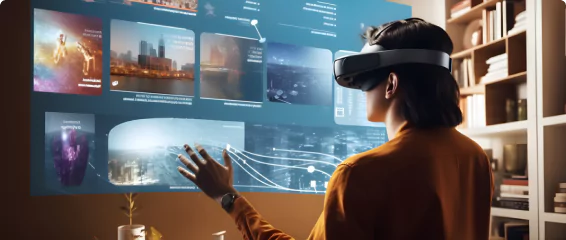Machine Learning and AI for revolution of Tech Companies are changing and streamlining businesses.
With incessant development in the tech world, banks have to adopt new technologies to offer secure services and fulfill customer expectations. This is why legacy application modernization in the banking and financial services industry (BFSI) is a very important aspect.
Legacy systems, often built on outdated technologies and architectures, are becoming increasingly difficult and expensive to maintain. They struggle to keep up with the demands for real-time processing, seamless customer experiences, and robust security. Data from McKinsey reveals that medium-sized banks can potentially save $100 million by modernizing their legacy systems.
Legacy application modernization in banking is not just about upgrading technology; it’s about future-proofing businesses. And that’s what we do at ViitorCloud – We make businesses future-ready with our digital transformation services. Here, we will discuss legacy application modernization in banking, its importance, and how ViitorCloud’s legacy application modernization services transform banking services.
What is Legacy Application Modernization in Banking?
FYI, legacy application modernization in banking is the process of transforming outdated software and hardware systems to meet current technological standards and customer expectations. These systems often built decades ago, have served as the backbone of banking operations, but they are now struggling to keep pace with the demands of the digital age.
They are typically characterized by monolithic architectures, outdated programming languages, and inflexible infrastructure, making them difficult to maintain, integrate, and scale.
Legacy application modernization in banking can involve various strategies, including:
- Replacing the entire system with a new, modern solution: This approach is often the most expensive and disruptive but offers the most comprehensive transformation.
- Migrating the system to the cloud: This can provide greater flexibility, scalability, and cost-effectiveness.
- Re-architecting the system using microservices: This approach breaks down the monolithic system into smaller, independent components that can be updated and deployed more easily.
- Updating specific components or functionalities of the system: This can be a more cost-effective way to address specific pain points or improve certain areas of the system by AI integration or better UI/UX.
The specific approach taken will depend on the unique needs and circumstances of each bank. However, the core objective is to increase the security, efficiency, customer experience, and agility of the banking system while reducing overall costs.
Modernize Your Banking Applications Today
Transform outdated systems into agile, secure, and scalable solutions. Embrace the future with our Legacy Application Modernization services tailored for the banking sector.
The Need for Legacy Application Modernization in Banking
The banking industry is facing increasing pressure to adapt to the digital age. Customers are demanding more personalized, convenient, and secure banking experiences. A report by PWC found that 61% of banking customers use digital channels weekly for most of their banking needs. Banks that fail to meet these expectations risk losing customers to more agile competitors.
Several factors are driving the need for legacy application modernization in banking, including:
1. Changing Customer Expectations
Customers today expect banks to provide seamless, intuitive, and personalized experiences across all channels, including online, mobile, and in-branch. Legacy systems often struggle to deliver this level of service.
2. Fintech
Fintech companies are disrupting the banking industry by offering innovative products and services that are often more user-friendly and cost-effective than those offered by traditional banks. Banks need to modernize their systems to compete with these new entrants.
3. Increasing Regulatory Pressure
Banks are facing increasing regulatory scrutiny, particularly in areas such as data security and privacy. Modern systems can help banks better comply with these regulations.
4. The Need for Agility and Innovation
Banks need to be able to respond quickly to changing market conditions and customer needs. Legacy systems often lack the agility and flexibility required for rapid innovation.
Read More: Legacy Application Modernization Is Critical in 2025
Advantages Legacy Modernization: Win-Win Strategy for Customers and BFSI
Legacy application modernization in banking is not just about improving the bank’s bottom line; it’s about creating a win-win situation for both the bank and its customers.
By modernizing its systems, a bank can provide its customers with the following benefits:
For Customers
Improved User Experience
Modern banking applications are designed with the user in mind, offering intuitive interfaces, personalized features, and seamless omnichannel experiences. Customers can access their accounts, make payments, and manage their finances more easily and conveniently.
Faster and More Efficient Services
Modern systems enable faster transaction processing, quicker loan approvals, and real-time account updates, enhancing the overall speed and efficiency of banking services. Customers no longer have to wait in long queues or endure lengthy processing times.
Enhanced Security and Privacy
Modern systems incorporate advanced security features, such as encryption and multi-factor authentication, to protect customer data from cyber threats and fraud. This instills confidence in customers, knowing their financial information is secure.
Access to Innovative Products and Services
Modern systems allow banks to introduce innovative products and services, such as personalized financial advice, mobile wallets, and peer-to-peer payment options. These offerings cater to the evolving needs and preferences of today’s tech-savvy customers.
For BFSI
Increased Customer Acquisition and Retention
A superior customer experience translates into increased customer satisfaction and loyalty, leading to higher customer retention rates and attracting new customers. A modern and user-friendly digital banking platform can be a key differentiator in a competitive market.
Reduced Operational Costs
Automation and streamlined processes result in significant cost savings, allowing banks to allocate resources to innovation and growth initiatives. A modern core banking system can reduce manual processing, paper-based workflows, and the need for expensive legacy system maintenance.
Improved Risk Management and Compliance
Modern systems provide better tools for risk assessment, fraud detection, and compliance monitoring, mitigating potential financial and reputational risks. They can help banks meet evolving regulatory requirements more effectively.
Enhanced Data Analytics and Business Intelligence
Modern systems enable banks to collect and analyze vast amounts of data, providing valuable insights into customer behavior, market trends, and operational performance. This data-driven decision-making can lead to more effective marketing campaigns, product development strategies, and risk management practices.
Legacy application modernization in banking represents a strategic approach that creates a mutually beneficial relationship between the bank and its customers.
Upgrade Legacy Systems with Ease
Drive innovation and efficiency in your banking operations. Explore how Legacy Application Modernization ensures seamless technology upgrades while minimizing risks.
Steps to Modernize Legacy Banking Applications
Modernizing legacy applications is a complex undertaking that requires a strategic and well-defined approach.
Here are some essential steps:
Step #1: Evaluate Your Legacy Banking Architecture
Conduct a comprehensive assessment of existing systems, identifying areas that need improvement. This evaluation should consider business drivers, IT drivers, and the alignment of legacy applications with the bank’s overall strategy.
Step #2: Define the Issues
Pinpoint specific problems within the legacy system that hinder user experience, security, or efficiency. Identify both strengths and weaknesses of the existing software.
Step #3: Select the Appropriate Modernization Approach
Choose from several modernization strategies, including full software replacement, incremental modernization, adopting a service-oriented architecture (SOA), or cloud migration.
Step #4: Choose Reliable Technologies and a Modernization Partner
Select a technology stack that aligns with the bank’s needs and objectives. Partner with experienced IT professionals like ViitorCloud as we have expertise in Agile and DevOps practices.
Step #5: Outline a Post-Modernization Strategy
Implement software engineering best practices to ensure the new system is maintainable and scalable. Develop a plan for employee training and adoption of the modernized system.
Step #6: Focus on Priority Areas
Prioritize modernization efforts in areas such as data governance and management, data migration and transformation, IT architecture optimization, and the implementation of DevOps/SecOps practices.
How ViitorCloud Can Help
We have more than 14 years of experience and expertise in providing digital transformation to BFSI and other industries. We offer specialized services to help banks successfully modernize their legacy systems.
How we ViitorCloud can help your bank:
- Strategic Planning and Assessment: We help banks define their modernization roadmap, conducting comprehensive assessments of existing systems and aligning technology solutions with business goals.
- Cloud Migration Solutions: We help banks transition seamlessly from on-premise systems to cloud-based platforms using secure methodologies.
- Application Modernization: Our team specializes in modernizing legacy applications using various approaches, including re-platforming, refactoring, and rewriting applications for cloud-native environments.
- API Integration: The company enables interoperability between legacy systems and modern applications through robust API frameworks.
- Data Analytics and AI/ML Integration: ViitorCloud integrates advanced data analytics and AI/ML capabilities into modernized banking systems, enabling data-driven insights and personalized customer experiences.
- Data Security and Compliance: We ensure the security and compliance of modernized systems, implementing robust security measures and adhering to industry regulations.
With ViitorCloud’s partnership and guidance, banks can overcome the challenges of legacy application modernization, accelerate their digital transformation journey, and open doors to new opportunities for growth and innovation. Contact us for a complimentary consultation on how we can modernize your legacy tech system.
Unlock the Potential of Modern Banking Technology
Revitalize your legacy applications to meet modern demands. Let us help you streamline operations with expert Legacy Application Modernization solutions.
Conclusion
Legacy application modernization in BFSI is not merely a technology upgrade; it’s a strategic imperative for survival and success in the dynamic financial market. With legacy modernization, banks can improve customer experiences, streamline operations, reduce costs, and mitigate risks.
However, this journey requires careful planning, expert guidance, and a trusted technology partner. We, ViitorCloud, with our industry knowledge and commitment to customer success, empower banks to adopt new technology with proper digital transformation strategies. So, click here to contact us now.
Join us on LinkedIn for exclusive insights and the latest developments in legacy application modernization from ViitorCloud! Let’s prepare for the future together!









